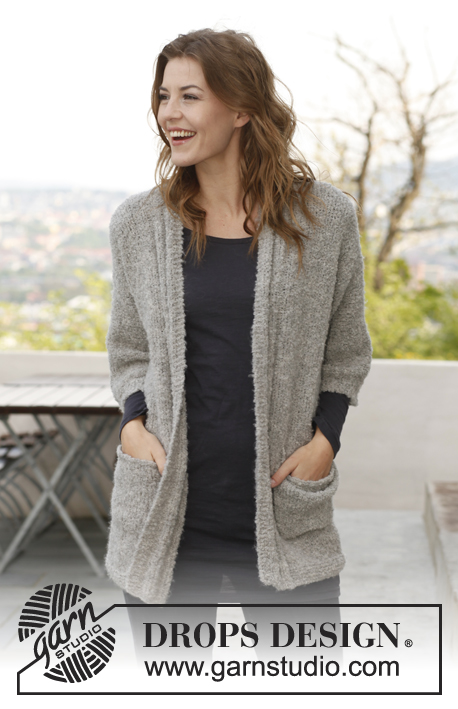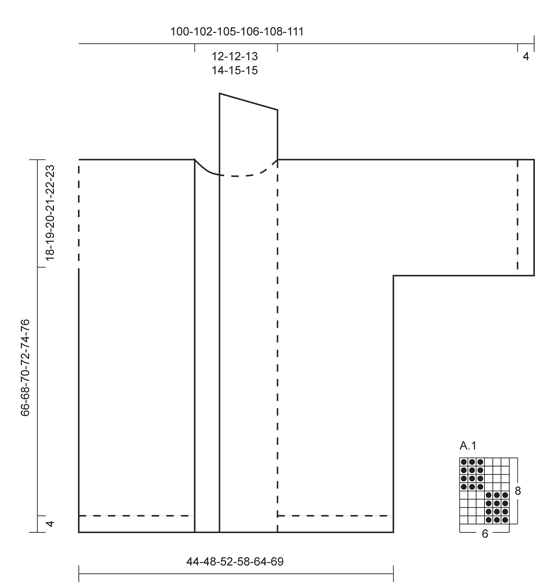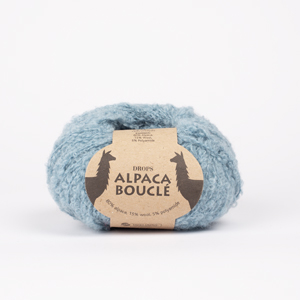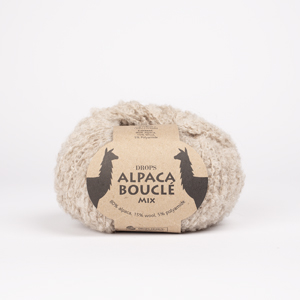Comments / Questions (62)
![]() Karine wrote:
Karine wrote:
Tere. Kuidas edasi kududa hõlma esiosaliistu? Enne oli 4silma ripsi ja soonik nüüd tuleb kududa: Koo parempidises koes, koo 6 esiliistu silmust . Kuidas pärast edasi kududa? Varrukal on 6 ripsi
17.10.2024 - 17:35DROPS Design answered:
Tere Karine! Esiliistu silmused lähevad kaeluseribaks üle pärast õlasilmuste mahakudumist ja kootakse ühtemoodi lõpuni. Juhendit on parandatud! Tänan teatamast!
05.11.2024 - 19:19
![]() Bettina wrote:
Bettina wrote:
Ich hänge bei den Kragenende an den Vorderteilen. Dort steht bei Größe M, nachdem man 7cm gestrickt hat: "zu Beginn jeder Hin-R 2x5 M und 1x6 M abketten." Da nur noch 16 M übrig sind, würde das ja heißen, dass ich sofort alle M abketten muss? Aber das kann ja auch nicht sein, da das Stück ja schräg werden soll. Wie geht es denn dort weiter? lG Bettina
02.10.2021 - 16:03DROPS Design answered:
Liebe Bettina, die 16 Maschen vom Kragen werden nach und nach abgekettet, am Anfang jeder Hinreihe: zuerst 5 Maschen x 2 dann die 6 übrige Maschen - dieses Video zeigt (für ein anderes Modell, dh mit anderen Maschenanzahl), wie man die Maschen für den Kragen so abkettet. Viel Spaß beim stricken!
04.10.2021 - 08:08
![]() Kathi wrote:
Kathi wrote:
Das habe ich alles schon fertig. Jetzt bin ich aber beim linken Vorderteil, und da steht folgendes: LINKES VORDERTEIL: = 43-47-49-55-59-64 M... GLEICHZEITIG am Ende der nächsten Rück nächsten Rück-R 46 neue M für den Ärmel anschlagen (=93M). wie ist das gemeint? LG
27.05.2020 - 12:48DROPS Design answered:
Liebe Kathi, Sie stricken eine Rückreihe und am Ende dieser Rückreihe schlagen Sie die 46 neuen Maschen, wenden und jetzt beginnen die Hinreihen mit den neuen Maschen für den Ärmel. Viel Spaß beim stricken!
27.05.2020 - 14:08
![]() Kathi wrote:
Kathi wrote:
Hallo, liebes Drops-Team, ich bin nun beim linken Vorderteil angekommen, und verstehe nicht, wann die Maschen für die Ärmel angeschlagen werden sollen. Wie ist das gemeint: „ GLEICHZEITIG am Ende der nächsten Rück-R 46 neue M für den Ärmel anschlagen“? Ich stricke M, sehr 46 Maschen. Aber was heißt, am Ende der nächsten Rückrunde? LG, Kathi
27.05.2020 - 09:58DROPS Design answered:
Liebe Kathi, am Ende der 2 ersten Reihe über nur Rückenteil schlagen Sie die 46 neuen Maschen, dh nachdem Sie die letzte Reihe vom Rumpfteil gestrickt haben (die Maschen von beiden Vorderteile stilllegen), stricken Sie die nächste Hinreihe über die Maschen vom Rückentil, am Ende dieser Reihe schlagen Sie 46 M an, wenden, die Rückreihe stricken und am Ende dieser Reihe schlagen Sie 46 M an. Viel Spaß beims tricken!
27.05.2020 - 11:40
![]() Kathi wrote:
Kathi wrote:
Hallo liebes Drops- Team, bei der Unterteilung des Rumpfteils habe ich festgestellt, dass mir zwei Maschen fehlen. Ich stricke Größe M. Wie kann ich das nun am besten lösen? Ich möchte natürlich nicht noch mal neu beginnen, und habe deshalb überlegt, die Mitte (Rückenteil) dann nur mit 80 Maschen zu stricken. Macht das Sinn? Oder gibt es eine andere Möglichkeit, die am Ende nicht zu sehr auffällt? Vielen Dank schon mal für die Unterstützung. LG
27.12.2019 - 11:05DROPS Design answered:
Liebe Kathi, leider können wir nicht jede Anleitung nach jeder Wunsch anpassen - am besten wenden Sie sich bitte an Ihrem Laden, wo Sie die Wolle gekauft haben - auch telefonisch oder per E-Mail. Viel Spaß beim stricken!
02.01.2020 - 11:28
![]() Dollygk wrote:
Dollygk wrote:
Hello and many thanks for all the free designs you offer! I am knitting this pattern but the design 'dips' after the edge rib stitches. Is it supposed to do this?? How can I send you a picture so you can understand. Thankyou all!
24.10.2019 - 10:14DROPS Design answered:
Dear Mrs Dollygk, make sure you keep correct tension, please show your work to your store (even sending a picture by mail), so that they can check together with you. Happy knitting!
24.10.2019 - 10:57
![]() Patty Manzi wrote:
Patty Manzi wrote:
What is the EASE measurement for this garment? The Finished Measurement says 41" (for Large size), but on the diagram is shows 52. Does it truly have 11 inch Ease for size Large? thank you.
01.10.2019 - 20:38DROPS Design answered:
Dear Mrs Manzi, we are not used to work with ease; to check your size, measure a similar garment you have and like the shape and compare them to the measurements in the chart (= in cm, not in inches). Read more about sizing and convert into inches here. Happy knitting!
02.10.2019 - 08:18Georgann B. Smallwood wrote:
I would like to use a cotton/linen blend yard for this jacket. (Aran 8 wpi) Do you have any size suggestions / instructions for this weight? Thank you! I love this pattern and want to use the yarn I have.
26.03.2018 - 01:55DROPS Design answered:
Dear Mrs Smallwood, you can use here DROPS Bomull-Lin, please find here all relevant informations about alternatives. Happy knitting!
26.03.2018 - 11:43
![]() Yvonne wrote:
Yvonne wrote:
Heb patroon exact gevolgd, steeds gemeten conform aanwijzingen, steekproef was goed etc. Toch was het vest al snel te kort en te wijd. En met het dragen werd dit steeds erger: het werd steeds korter en wijder! Ik kan het vest helaas niet meer dragen, het is helemaal uit verhouding. Ik heb ook poncho 133-4 gemaakt en daarbij gebeurt dit ook, alleen bij een poncho komen de verhoudingen minder precies, dus dan maar korter en wijder. Maar hoe kan het dat deze wol zo reageert na correcte verwerking?
20.12.2017 - 23:38DROPS Design answered:
Hallo Yvonne, Dat is erg jammer om te horen. Voor klachten over het garen kun je het beste even contact opnemen met het verkooppunt waar je het garen hebt gekocht. Zij kunnen je eventueel verder helpen.
12.03.2018 - 10:58
![]() Lene Thorkelin wrote:
Lene Thorkelin wrote:
Jeg bryder mig ikke om bouclé garn. Kan I anbefale en anden garntype til denne model?
24.09.2017 - 10:31DROPS Design answered:
Hei Lene. DROPS Alpaca Boucle tilhører garngruppe C og du kan velge andre kvaliteter vi har i samme garngruppe. Om du ønsker ensfarget ullkvalitet kan du velge DROPS Brushed Alpaca Silk, DROPS Nepal, DROPS Big Merino, DROPS Air og DROPS Alaska eller multifarget ved DROPS Big Delight. Du kan også velge mellom DROPS Paris og DROPS Bomull-Lin om du ønsker bomullsgarn. Bare gå inn på oversikten over garn og velg kvalitet og farger, men HUSK å overholde strikkefastheten som er oppgitt i oppskriften. God Fornøyesle!
27.09.2017 - 08:19
Snuggle#snugglecardigan |
|||||||
 |
 |
||||||
Set consists of: Knitted DROPS jacket and neck warmer in ”Alpaca Bouclé.” Size: S - XXXL.
DROPS 142-21 |
|||||||
|
GARTER ST (back and forth on needle): K all rows. GARTER ST (in the round on needle): * K 1 round and P 1 round *, repeat from *-*. BAND STS: At beg of row from RS: Work 4-4-4-6-6-6 sts in garter st, * K 3, P 3 *, repeat from *-* 1 more time = 16-16-16-18-18-18 sts. At end of row from RS: Work * P 3, K 3 *, repeat from *-* 1 more time, 4-4-4-6-6-6 sts in garter st = 16-16-16-18-18-18 sts. From WS work the outermost 4-4-4-6-6-6 sts in garter st, and K over K and P over P over the other band sts. INCREASE TIP: Inc 1 st in each side as follows: K 1, make 1 YO, work until 1 st remains, make 1 YO, K 1. On next row work YO twisted to avoid holes. MEASURING TIP: Measure when piece is flat, it is important not to stretch the piece when measuring. PATTERN (applies to neck warmer): See diagram A-1, diagram shows all rows in 1 repetition of pattern. -------------------------------------------------------- BODY: Worked back and forth on circular needle from mid front. Cast on 160-176-186-208-226-246 sts on circular needle size 5 mm with Alpaca Bouclé. On 1st row (= RS) work as follows: Work BAND STS - read explanation above, work in GARTER ST - read explanation above - until 16-16-16-18-18-18 sts remain on row, work BAND STS. Continue in garter st over the middle sts and 16-16-16-18-18-18 band sts in each side for 4 cm. REMEMBER THE KNITTING TENSION! Then work in stocking st with 16-16-16-18-18-18 band sts in each side. When piece measures 48-49-50-51-52-53 cm, divide the piece 43-47-49-55-59-64 sts in from each side (= front piece, there are 74-82-88-98-108-118 sts on back piece), and finish each part separately. BACK PIECE: = 74-82-88-98-108-118 sts. Continue in stocking st - AT THE SAME TIME at end of the next 2 rows, cast on 48-46-45-41-38-35 new sts for sleeve in each side = 170-174-178-180-184-188 sts. Continue in stocking st - but work the outermost 6 sts in each side in garter st until finished measurements (= band on sleeve in each side). When piece measures 64-66-68-70-72-74 cm, cast off the middle 18-18-20-22-24-24 sts for neck and finish each shoulder separately. On next row from neck, cast off 1 st = 75-77-78-78-79-81 sts remain on shoulder. Loosely cast off all sts when piece measures 66-68-70-72-74-76 cm. NOTE: Make sure that the cast off edge is not too tight. LEFT FRONT PIECE: = 43-47-49-55-59-64 sts. Continue in stocking st and 16-16-16-18-18-18 band sts towards mid front - AT THE SAME TIME at end of next row from WS, cast on 48-46-45-41-38-35 new sts for sleeve = 91-93-94-96-97-99 sts. Continue in stocking st and band sts towards mid front but work the outermost 6 sts at beg of row seen from RS in garter st until finished measurements (= band on sleeve). When piece measures 66-68-70-72-74-76 cm, cast off on next row from RS the first 75-77-78-78-79-81 sts for shoulder = 16-16-16-18-18-18 band sts remain for collar. NOTE: Make sure that the cast off edge is not too tight. Continue to work over these band sts until collar measures 7-7-8-8-9-9 cm from the shoulder. Then cast off at beg of every row from RS as follows: Cast off 5 sts 2-2-2-0-0-0 times, 6 sts 1-1-1-3-3-3 times. RIGHT FRONT PIECE: Work as left front piece but reversed. ASSEMBLY: Sew shoulder and sleeve seams in front loop of outermost sts. Sew collar tog mid back and sew on to neck line at the back of neck. Sew seams under sleeves in front loop of outermost sts. POCKET: Worked back and forth on needle. Cast on 24-24-24-26-26-26 sts on circular needle size 5 mm with Alpaca Bouclé. Then work in stocking st. When piece measures 3 cm, inc 1 st in each side - READ INCREASE TIP. Repeat inc every 3 cm a total of 3 times = 30-30-30-32-32-32 sts. Cast off all sts when piece measures 16-16-16-17-17-17 cm. Sew pockets on to front piece, approx. 10-10-11-11-12-12 cm from cast on edge and 12 cm from mid front. NOTE: Right and left edge on pocket are sewn parallel with band mid front. -------------------------------------------------------- NECK WARMER: Worked in the round. Loosely cast on 120 sts on circular needle size 5 mm with Alpaca Bouclé. Work 4 rounds in GARTER ST - read explanation above. Then work A.1 in the round. When piece measures approx. 35 cm (finish with last row in pattern), work 4 rounds in garter st and loosely cast off all sts. NOTE: Make sure that the cast off edge is not too tight. |
|||||||
Diagram explanations |
|||||||
|
|||||||

|
|||||||
Have you finished this pattern?Tag your pictures with #dropspattern #snugglecardigan or submit them to the #dropsfan gallery. Do you need help with this pattern?You'll find 7 tutorial videos, a Comments/Questions area and more by visiting the pattern on garnstudio.com. © 1982-2025 DROPS Design A/S. We reserve all rights. This document, including all its sub-sections, has copyrights. Read more about what you can do with our patterns at the bottom of each pattern on our site. |
|||||||


















































Post a comment to pattern DROPS 142-21
We would love to hear what you have to say about this pattern!
If you want to leave a question, please make sure you select the correct category in the form below, to speed up the answering process. Required fields are marked *.